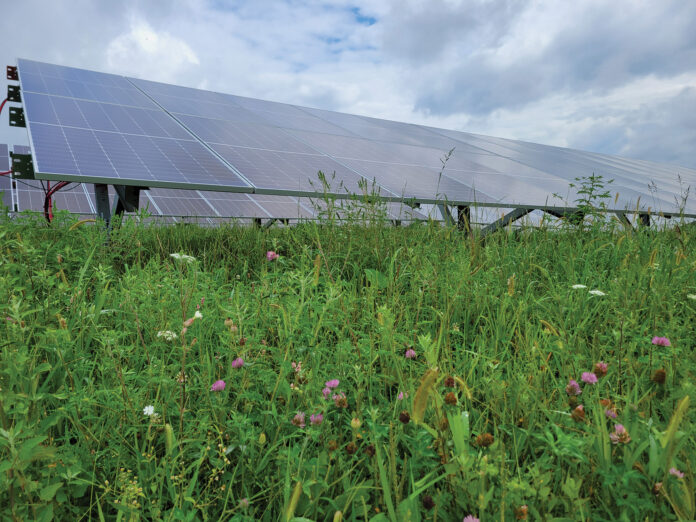
CLINTON, Pa. — Don and Barb Craig were not interested in leasing their farmland for solar energy. The couple ignored the letters in the mail and the phone calls that came next.
It wasn’t until their neighbor stopped by that they thought twice about the land agents who had been hounding them with offers to lease their land.
Duane Miller had been carefully considering the offers for solar leases from the land agents. He had solar panels powering his farm already, so he was keenly interested in leasing his land for large-scale solar development. Miller needed the Craigs to sign up their abutting land in order for a project to move forward.
“I said, ‘If they’re that interested, they’ll show up at the door,’” Don recalled telling Miller. A few days later, an agent knocked on the front door, Don Craig said.
That was more than five years ago. Now the Craigs’ and Millers’ land is a sea of glass solar panels, producing an estimated 35,700 megawatt hours of electricity to the University of Pittsburgh each year to help it reach its sustainability goals. The solar farm consists of 55,000 panels spread across 68 acres on the line between Beaver and Allegheny counties.
Representatives from Vesper Energy, the company that developed and operates the project, and the University of Pittsburgh cut a ribbon during a ceremony Aug. 16 to celebrate the project’s completion.

“Our partnership with Vesper on the Gaucho solar array demonstrates Pitt’s commitment to not just purchasing renewable electricity, but purchasing local renewable electricity that has cascading local, economic and environmental benefits,” said Aurora Sharrard, Pitt’s Executive Director of Sustainability.
The project is the first Vesper has completed in western Pennsylvania. The Dallas-based energy company is developing another solar project in Lawrence County, Pennsylvania.
The University of Pittsburgh, through a power purchasing agreement, will buy all of the power generated by the array for the next 20 years. The facility will provide about 18% of the university’s electrical needs and reduce its greenhouse gas emissions by 15,000 metric tons of carbon dioxide each year, said Scott Bernotas, Pitt’s Vice Chancellor of Facilities Management.
Decisions
The project represents more than just Pitt’s desire to reach carbon neutrality by 2037. For the Craig family, it represents a way to retire comfortably, something few farmers get to do these days.
Don Craig’s father, Harry, bought the farm in 1954. He worked as a coal miner and ran the farm on the side. Don Craig took it over in 1974 and turned it into a dairy farm. The farm grew over the years. They added a free-stall barn and a milking parlor. At one point they were milking up to 110 cows, Barb Craig said.
The couple raised three children on the farm. One of their sons, Don Jr., was slated to take over the farm from his parents, but he died in a motorcycle accident in 2007.
They were milking about 75 cows at the time they sold the milking herd. The entire herd went to a farm near Somerset, Pennsylvania in December 2021.
“I miss the cows,” Don Craig said. “I don’t miss the milking schedule.”
The decision to get out of dairy farming wasn’t easy, nor was it simple. Don and Barb loved the cows and loved the work, but they were both getting older. Their other children had no interest in taking over the farm. The solar lease wasn’t the only reason they sold the herd, but it played a part.
The steady income from a solar lease, spread out over 30 years, would give them stability to retire and continue farming, albeit at a slower pace. They’d also started getting royalty payments from a nearby gas well, drilled by Range Resources.
Advice
Don Craig still farms about 500 acres. He has a few beef cattle, too. He has some advice for other farmers or landowners considering a solar lease.
“Get someone to negotiate for you that knows the situation,” he said. He got a few conditions added to his contract to allow him to continue farming his land, but in retrospect, he would’ve liked another set of knowledgeable eyes to look at the contract and advocate on his behalf.
One of the conditions for the Craigs to sign the lease was that he needed access to fields that lay behind the proposed solar array. The layout of the solar field landlocked some of his corn fields. Don Craig said it was a sticking point during negotiations, as landowners are typically not allowed access to leased land once construction is underway.
Eventually, he got a 50-foot right of way through the solar facility to get to his fields and a gate leading straight from his farm into the array. The access road through the solar panels is wide enough for Don to get his combine and other large equipment through without damaging the panels.










Rachel,
I love that you follow the hot topics in agriculture. This was a very revealing article. Good for you.
I noted that you are now the editor of Farm and Dairy. When did that happen. Sorry I missed the announcement. Congratulations. The rural community on both sides of the state line will benefit from your dedication and curiosity. Keep up the good work. You are following some other amazing women.
Thank you so much, Carol Ann!